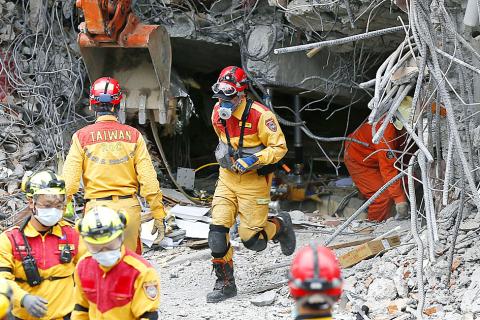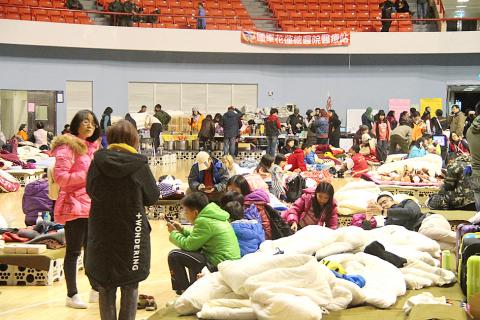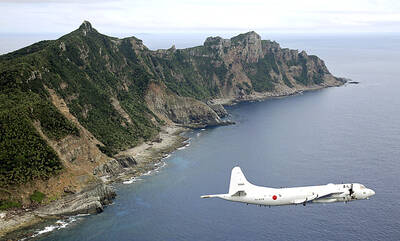Seven people were killed and 260 injured after a magnitude 6.0 earthquake struck off the coast of Hualien County on Tuesday night, the Central Emergency Operation Center said yesterday.
The center’s data showed that four buildings in Hualien City had collapsed or tilted due to the earthquake: the Marshal Hotel (統帥飯店), the Yun Men Tsui Ti (雲門翠堤大樓) commercial and residential building and two apartment buildings on Guosheng 6th Street.
As of 9:30pm yesterday, 67 people were reported missing, 39 of whom were thought to have been in the Yun Men Tsui Ti building.

Photo: CNA
However, rescue efforts at the Yun Men Tsui Ti building have been precarious, with the building tilting ever more toward the ground amid multiple aftershocks.
A total of 31,558 households were waiting for their water supply to resume, while 186 households were left without electricity, the data showed.
About 560 people have been placed in shelters after being evacuated from their homes on Tuesday night, the data showed.

Photo: Ritchie B. Tongo, EPA
Huang Jui-tien (黃瑞添), a resident of Hualien County’s Jian Township (吉安), told the Taipei Times in a telephone interview that even though there have been aftershocks since a magnitude 5.8 earthquake on Sunday night, he felt that Tuesday’s earthquake was much bigger, because things started to shake vertically instead of horizontally.
Huang said he and his family rushed out of their home during the earthquake and returned to find that all of the bonsai plants in the house had fallen to the ground.
“We were afraid to go back to sleep again, because the aftershocks continued almost nonstop,” he said.

Photo: Peter Lo, Taipei Times
Most restaurants and shops in the area were closed yesterday, Huang said, adding that convenience stores had run out of hot food.
Asked what his family would do, as the aftershocks are expected to continue over the next few weeks, he said: “Well, life has to go on.”
The Ministry of National Defense has deployed 661 military personnel to assist rescue efforts.

Photo: Lin Hsin-han, Taipei Times
Central Weather Bureau (CWB) data showed that Tuesday’s earthquake, which measured magnitude 6.0 on the Richter scale, occurred at 11:50pm at a depth of 10km and its epicenter was 18.3km northeast of Hualien County Hall, which is near the coast.
The earthquake’s seismic intensity was level 7 in Hualien County’s Taroko Gorge (太魯閣峽谷) and Yilan County’s Nanao Township (南澳).
Seismic intensity refers to the degree of vibration felt at a location during an earthquake.
On the nation’s zero-to-seven seismic intensity scale, level 7 indicates shaking so violent that people cannot move at will.
As of 5pm yesterday, the bureau had recored 159 aftershocks since Tuesday night’s big quake.
The bureau had previously said that Sunday’s magnitude 5.8 earthquake was the main earthquake and that it expected tectonic movement to gradually cease after multiple aftershocks.
However, it changed its evaluation yesterday, saying that Tuesday’s magnitude 6.0 temblor was the main earthquake and Sunday’s was one of its 94 foreshocks.
“This seismic sequence has completely changed the way we think about earthquakes in this region,” Seismological Center Acting Director Chen Kuo-chang (陳國昌) said.
Chen confirmed that Tuesday’s earthquake was the largest in Hualien County since the bureau began conducting more precise observations of earthquakes in 1972.
The bureau said that the earthquake occurred as a result of an interaction between the Philippine Sea Plate and Eurasia Plate, with some seismologists saying that this might trigger movement of the Milun Fault, along which the damaged buildings were constructed.
In related news, the Ministry of Foreign Affairs said that 31 foreign nationals were reportedly affected by Tuesday’s earthquake, including 14 South Koreans, nine Japanese, two Czechs, two Singaporeans and one Philippine national.
The nationalities of the remaining three have yet to be confirmed, the ministry said in a statement.
The two Singaporeans and 13 South Koreans were in a temporary shelter at a stadium in Hualien, with only one of them, a South Korean, having sustained minor injuries, it said.
The other 16 foreign nationals received treatment for various injuries at four hospitals in the Hualien area and were later discharged or would soon be discharged, the statement said.
The injuries ranged from wrist and foot injuries to dry powder inhalation, it added.
One South Korean woman living in the Yun Men Tsui Ti building was rescued at about 10am yesterday, the statement said.
Additional reporting by CNA

MISINFORMATION: The generated content tends to adopt China’s official stance, such as ‘Taiwan is currently governed by the Chinese central government,’ the NSB said Five China-developed artificial intelligence (AI) language models exhibit cybersecurity risks and content biases, an inspection conducted by the National Security Bureau (NSB) showed. The five AI tools are: DeepSeek, Doubao (豆包), Yiyan (文心一言), Tongyi (通義千問) and Yuanbao (騰訊元寶), the bureau said, advising people to remain vigilant to protect personal data privacy and corporate business secrets. The NSB said it, in accordance with the National Intelligence Services Act (國家情報工作法), has reviewed international cybersecurity reports and intelligence, and coordinated with the Ministry of Justice Investigation Bureau and the National Police Agency’s Criminal Investigation Bureau to conduct an inspection of China-made AI language

LIMITS: While China increases military pressure on Taiwan and expands its use of cognitive warfare, it is unwilling to target tech supply chains, the report said US and Taiwan military officials have warned that the Chinese People’s Liberation Army (PLA) could implement a blockade within “a matter of hours” and need only “minimal conversion time” prior to an attack on Taiwan, a report released on Tuesday by the US Senate’s China Economic and Security Review Commission said. “While there is no indication that China is planning an imminent attack, the United States and its allies and partners can no longer assume that a Taiwan contingency is a distant possibility for which they would have ample time to prepare,” it said. The commission made the comments in its annual

‘TROUBLEMAKER’: Most countries believe that it is China — rather than Taiwan — that is undermining regional peace and stability with its coercive tactics, the president said China should restrain itself and refrain from being a troublemaker that sabotages peace and stability in the Indo-Pacific region, President William Lai (賴清德) said yesterday. Lai made the remarks after China Coast Guard vessels sailed into disputed waters off the Senkaku Islands — known as the Diaoyutai Islands (釣魚台) in Taiwan — following a remark Japanese Prime Minister Sanae Takaichi made regarding Taiwan. Takaichi during a parliamentary session on Nov. 7 said that a “Taiwan contingency” involving a Chinese naval blockade could qualify as a “survival-threatening situation” for Japan, and trigger Tokyo’s deployment of its military for defense. Asked about the escalating tensions

DISPUTE: A Chinese official prompted a formal protest from Tokyo by saying that ‘the dirty head that sticks itself out must be cut off,’ after Takaichi’s Taiwan remarks Four armed China Coast Guard vessels yesterday morning sailed through disputed waters controlled by Japan, amid a diplomatic spat following Japanese Prime Minister Sanae Takaichi’s comments on Taiwan. The four ships sailed around the Senkaku Islands — known as the Diaoyutai Islands (釣魚台) to Taiwan, and which Taiwan and China also claim — on Saturday before entering Japanese waters yesterday and left, the Japan Coast Guard said. The China Coast Guard said in a statement that it carried out a “rights enforcement patrol” through the waters and that it was a lawful operation. As of the end of last month,